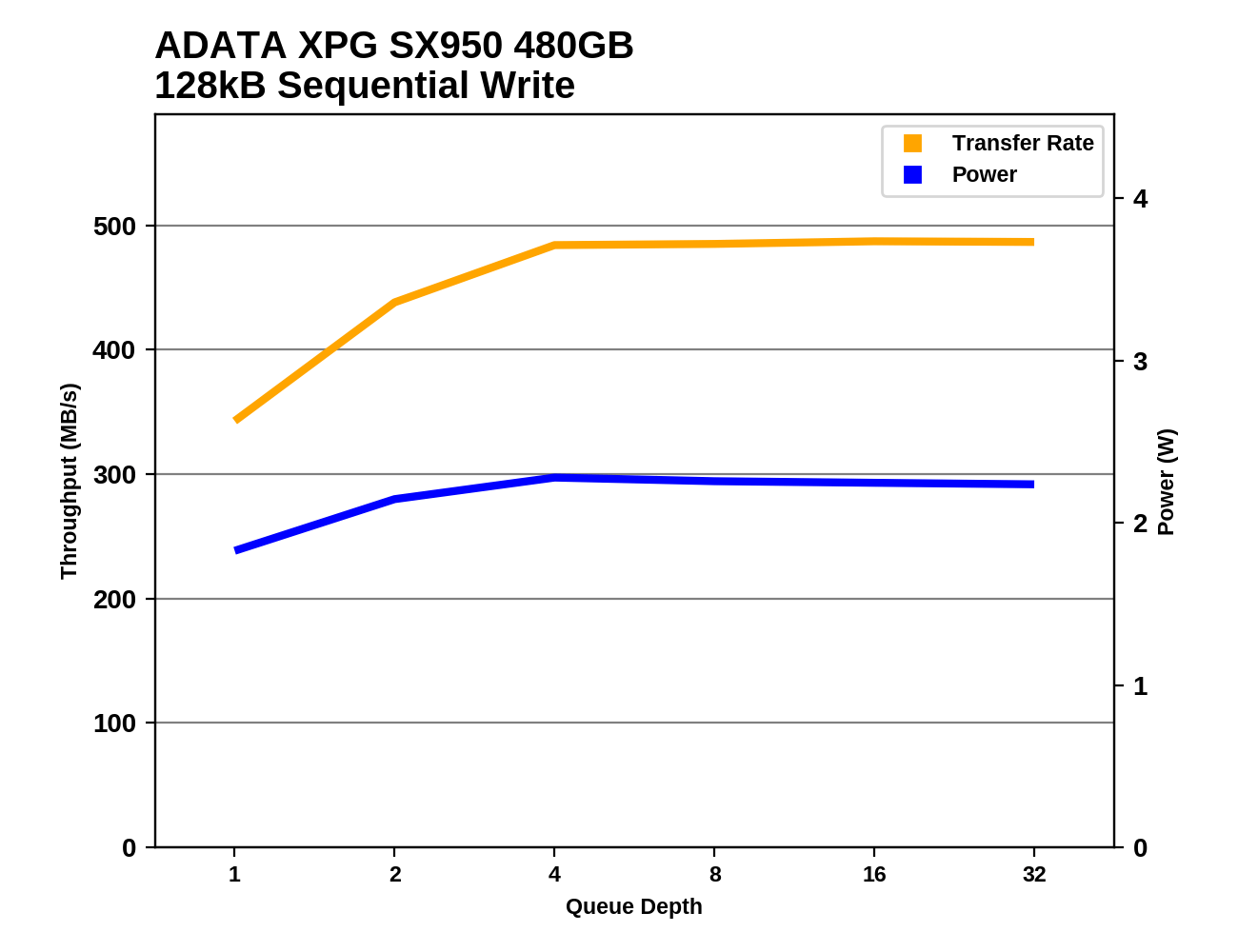The ADATA XPG SX950 480GB SSD Review: In Search of Premium
by Billy Tallis on October 9, 2017 8:00 AM ESTSequential Read Performance
Our first test of sequential read performance uses short bursts of 128MB, issued as 128kB operations with no queuing. The test averages performance across eight bursts for a total of 1GB of data transferred from a drive containing 16GB of data. Between each burst the drive is given enough idle time to keep the overall duty cycle at 20%.

For short bursts of sequential reads at QD1, the ADATA XPG SX950 comes reasonably close to saturating the SATA bus and is not significantly outperformed by any other SATA drive.
Our test of sustained sequential reads uses queue depths from 1 to 32, with the performance and power scores computed as the average of QD1, QD2 and QD4. Each queue depth is tested for up to one minute or 32GB transferred, from a drive containing 64GB of data.

On the longer sequential read test, the SX950's performance drops dramatically, leaving it as one of the slowest SSDs in this bunch.

With such poor sustained read performance, the SX950's efficiency is quite low, though all the other drives with Intel/Micron 32L 3D NAND also rank at the bottom of this chart with the SX950 even when they deliver higher performance.
 |
|||||||||
Sustained sequential read speeds on the ADATA SX950 do not increase with higher queue depths. The burst test showed that higher speeds are possible in favorable conditions, but giving the SSD more work to do when it is already bottlenecked internally doesn't help things.
Sequential Write Performance
Our test of sequential write burst performance is structured identically to the sequential read burst performance test save for the direction of the data transfer. Each burst writes 128MB as 128kB operations issued at QD1, for a total of 1GB of data written to a drive containing 16GB of data.

The burst sequential write speed of the SX950 is about average, and virtually identical to its TLC-based SU800 sibling; this test is primarily hitting the SLC caches so it's unsurprising to see the two perform the same.
Our test of sustained sequential writes is structured identically to our sustained sequential read test, save for the direction of the data transfers. Queue depths range from 1 to 32 and each queue depth is tested for up to one minute or 32GB, followed by up to one minute of idle time for the drive to cool off and perform garbage collection. The test is confined to a 64GB span of the drive.

The sustained sequential write speeds of the SX950 fall short of the top SATA drives and are instead slightly lower than the Crucial BX300, but since this test doesn't fill the drive the SX950's write performance doesn't end up falling through the floor.

The SX950's power efficiency during the sustained sequential write test is pretty good, though the Crucial MX300 and OCZ VX500 still manage to beat it. The SX950 has about a 20% advantage over the BX300, which is the next most efficient drive using 3D MLC.
 |
|||||||||
The SX950 doesn't reach full sequential write performance until QD4, and its saturation speed is slightly slower than drives like the Samsung 850 PRO (which is very nearly at full speed by QD2). Performance and power consumption remain steady through the second half of the test as the drive still has plenty of SLC cache remaining.










45 Comments
View All Comments
Cliff34 - Monday, October 9, 2017 - link
It is almost for almost all your needs, budget or performance, better stick with Samsung's SSDs.Chaitanya - Monday, October 9, 2017 - link
Sadly Adata has diarrhea when it comes to releasing SSDs. They drop too many SSDs on market too fast.chrnochime - Tuesday, October 10, 2017 - link
You!= everyone under the sun. And no not everyone wants to be stuck with a freakin TLC SSD, as much as you'd like to believe. How hard can that be to grasp? Wait rhetorical question LOLDr. Swag - Monday, October 9, 2017 - link
Is ADATA out of their minds? This drive performs on the budget end of the spectrum yet they're pricing it above the 850 pro?!?jardows2 - Monday, October 9, 2017 - link
Before I read the article, I thought I knew the conclusion - It will perform under Samsung products, and be priced a bit too high for the comparative performance. I guess I was highly optimistic about this drive! What is up with that price?Flunk - Monday, October 9, 2017 - link
ADATA's pricing is truely perplexing. Maybe their market is "people who don't read SSD reviews", so they think they can write "premium" on the box and it justifies the price. Maybe they're pricing just so they can have it 50% off MSRP all the time. Regardless, I'd argue there isn't really such thing as a premium SATA SSD anymore because even budget NVMe drives throttle them.4x PCI-E 3.0 is 32Gbps, Fully 4 times the bandwidth of SATA 3. That's not a generational leap, it's a whole new ballgame, especially if you consider the reduction in overhead that comes with NVMe. SATA drives are now relegated to being upgrades for older desktops and notebooks, there is no "high-end" left.
ddriver - Monday, October 9, 2017 - link
sata 3 is 6 gbits, IIRC 6 * 4 is 24Also, 4 times faster drive doesn't make a system 4 times faster. It is true that before SSDs, storage was pretty much the bottleneck, but if you look at real world benchmarks, the difference between a SATA and a NVME SSD is a few percents in 99% of the cases.
xeroshadow - Monday, October 9, 2017 - link
I can attest to this. I went from an Intel 330 series to NVMe Samsung 960 and barely noticed any difference except in some launch speeds of certain programs. I was disappointed.Samus - Monday, October 9, 2017 - link
It's like CPU's. Programs just haven't caught up to their capability yet. Other than mass data transfer (between SSD's no less) you are likely to see any real-world performance boost from NVMe over SATA3. Decompressing is the only area I personally benefit from NVMe; it unRAR's files much faster than a SATA3 drive.But gaming, general usage, and even content creation I don't notice a difference.
saratoga4 - Monday, October 9, 2017 - link
It's because while the transfer rate of high end NVMe drives is much higher, that really doesn't help you load a few dozen 10 MB files all that much faster. For lots of small to medium sized files, you need lower access latency, and NVME drives are little better than SATA, so until that improves the main place NVME will have an edge is copying files between NVME drives.